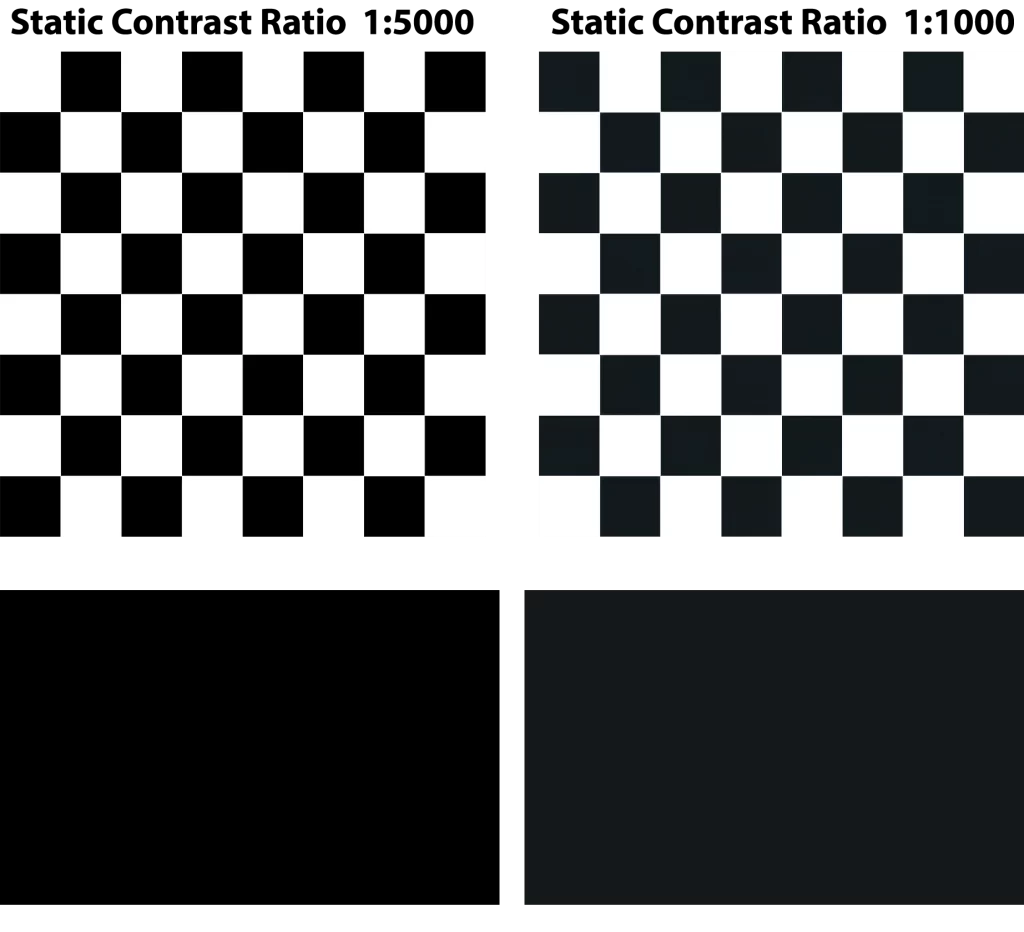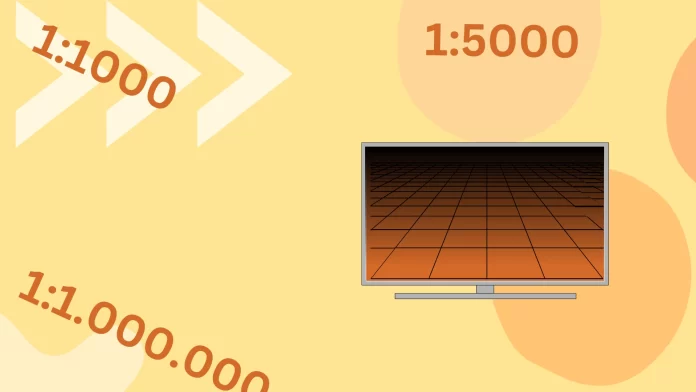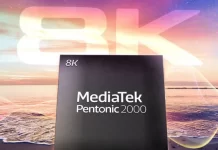TV contrast ratio is a term that often pops up when discussing display quality, but what does it really mean? In simple terms, the contrast ratio represents the difference between the brightest and darkest points a TV can display. It measures how well a screen can differentiate between the lightest whites and the deepest blacks. For instance, a contrast ratio of 1000:1 means that the brightest white on the screen is 1000 times brighter than its darkest black. This ratio plays a crucial role in determining the depth, clarity, and overall visual experience of what we watch. A higher contrast ratio means a brighter and more realistic image, making viewing content more enjoyable.
However, manufacturers often manipulate these ratios to give their products the appearance of superiority. To avoid falling into the trap of such marketing tricks, it is necessary to have a good understanding of what contrast ratio is and how it affects image quality
Contrast ratio – basic understanding
TV contrast ratios denote the difference between the brightest and darkest points a display can produce. This specification is vital as it affects the vividness and detail of visuals. Consider a nighttime city scene; a TV with a good contrast ratio will depict the dark expanse of the sky while simultaneously highlighting the intricate details of city lights. A subpar contrast would result in a less vibrant and detailed image.
There are two primary types of contrast ratios: static and dynamic.
- Static contrast ratio: This measures the luminance difference between the brightest white and the darkest black that a screen can display simultaneously. It gives a genuine idea of a screen’s capability in a single frame.
- Dynamic contrast ratio: The “dynamic contrast ratio” refers to the range between the brightest white and the darkest black a display can show over a period, but not simultaneously. For example, during dark scenes, a TV might reduce its backlight to enhance black levels and increase it during brighter scenes. The vast numbers like 1,000,000:1 are derived from comparing these manipulated extremes.
When assessing a TV’s contrast, it’s more reliable to consider the static contrast ratio. This metric clarifies how well a TV displays content, as manufacturers can sometimes exaggerate dynamic contrast numbers.
Static contrast ratio – what is it?
Static Contrast Ratio, also termed “native” or “onscreen” contrast, measures the luminance distinction between a screen’s brightest whites and darkest blacks displayed simultaneously within a single frame. It’s a more trustworthy indicator of a display’s genuine visual performance.
Imagine a movie scene where a knight stands in glaring sunlight with a shadowy forest backdrop. The static contrast ratio ensures you perceive both the gleaming armor and the forest’s subtle intricacies distinctly.
Typically, you might encounter ratios like 5000:1, indicating that the brightest white is 5,000 times more luminous than the deepest black. A greater disparity between these two figures indicates more detailed screen visuals.
A straightforward way to visualize static contrast ratio is a checkerboard pattern with stark white and intense black squares. While this image doesn’t perfectly emulate real-life viewing, it offers an insight into a TV’s contrast capabilities, demonstrating its management of light and dark segments.

For optimum visuals, a static contrast ratio should be a minimum of 1000:1. Higher-end TVs often boast ratios like 2000:1, 2500:1, or even 5000:1. Generally, a higher ratio implies superior image clarity.
How to calculate TV contrast ratio
Contrast measurement is a straightforward procedure. Typically, manufacturers or tech reviewers employ a checkerboard pattern composed of alternating black and white squares to gauge it. The process begins by setting the TV’s white squares to a specific brightness level, usually around 100 units (cd/m2).
A specialized tool called a Lux meter is then used to measure the brightness of the central white square. Subsequently, the luminance of the surrounding black squares is gauged, and their average darkness is computed.
The essence of measuring contrast lies in discerning the difference in brightness between the white and black areas. The contrast ratio, a key metric, elucidates this difference. It’s computed by dividing the luminance of the white square by that of the black square.
Dynamic contrast ratio – what the difference?
Dynamic contrast ratio is a specification for TVs and other displays. It represents the difference between the brightest white and the darkest black a display can produce over time, but not necessarily simultaneously.
The term “dynamic” is used because this measure involves manipulating the backlight brightness or other display settings to achieve these extremes in different situations. For instance, when displaying a very dark scene, the backlight of an LCD TV might be dimmed to make the blacks look deeper. Conversely, the backlight might be turned up in a bright scene to make the scene look brighter. By comparing the darkest black from the dark scene to the brightest white from the bright scene, manufacturers derive a dynamic contrast ratio.
Yet, a significant hurdle emerges when it comes to pinning down the dynamic contrast ratio – the absence of standardized testing procedures for measurement and reporting, which differs among manufacturers. This leads to inconsistent ratios being reported.
Two TVs from distinct manufacturers might boast dynamic contrast ratios of 80,000:1 and 60,000:1, respectively. However, the actual variance could be insignificant. In fact, there are instances where TVs with lower dynamic contrast ratios exhibit superior real-life contrast ratios compared to TVs with higher ratios.

Here’s how the picture appears in a test involving TVs with varying dynamic contrast ratios. As you can observe, the numbers don’t always accurately represent reality.
Consequently, it’s wise not to depend heavily on the dynamic contrast ratio as a decisive factor when selecting a TV. I want to point out that some OLED TV manufacturers assert that their TVs possess an “infinite” dynamic contrast ratio but more on that later.
While dynamic contrast ratio acts as a theoretical benchmark for displays, there is also a “Dynamic Contrast” feature common in many televisions that dynamically changes the image on the screen depending on the content being viewed.
Dynamic Contrast is a technology that automatically adjusts the contrast and brightness of a display based on the content being shown. It works by dynamically altering the backlight intensity or, in some cases, adjusting the pixel values to enhance the difference between the darkest and brightest parts of the image.
A small example: Imagine you’re watching a movie with lots of different scenes. Some scenes are really bright, like a sunny beach, and others are darker, like a space. Dynamic contrast makes the screen brighter when showing a white picture.

From the example, it’s clear that Dynamic contrast didn’t just brighten the white color; it also raised the black level, resulting in an overall increase in picture contrast.
But Dynamic contrast also dims when it’s supposed to be dark. During dimly lit scenes, Dynamic contrast can unveil details that might otherwise remain hidden, but it carries a significant drawback.

Frequently, this feature eliminates small elements from the picture, prompting some users to advise against its use.
Summarize
Dynamic contrast ratio is a specification often provided by manufacturers to indicate the difference in luminance between the brightest white and the darkest black a display can produce in different scenes, but not simultaneously.
Dynamic Contrast is a technology or feature in many modern displays that dynamically adjusts the screen’s contrast and brightness based on the content being shown.
It’s two different things! I wanted to highlight this point because it took me some time to understand.
Best сontrast ratio: QLED Vs OLED
Deciding which technology has the best contrast level is a bit tricky because they’re quite different. Here’s a simple look at these two technologies:
QLED, from Samsung, uses tiny dots that make bright colors when light shines on them. It’s a bit like how regular TVs work. QLED TVs have really nice and pure colors because of these special dots. OLED is different. It uses a special material that lights up when electricity passes through it. This material helps create the picture you see on the TV screen.
OLED has a unique advantage. It can turn off individual pixels completely, creating a big difference between the brightest and darkest parts of the picture. This ability adds depth and intensity to the scenes.
However, QLED fights back with its own strength. QLED TVs can get super bright, which is important for showing off the brightest parts of the picture. This is crucial for making high-quality HDR content look amazing.

So, which TV is better for you? If your room is bright, QLED’s brightness will make everything look colorful and lively. But if you like watching in the dark or creating a theater-like setup at home, OLED’s ability to handle dark scenes will make the experience more exciting.
IPS, VA, and TN сontrast ratio
Similar to OLED and QLED, various types of LCD panels impact the contrast ratio of your screen in distinct manners. Different types of screen panels, such as IPS, TN, and VA, have different contrast ratios. IPS and TN panels usually have a contrast ratio of around 1000:1. Most VA panels have a higher contrast ratio of up to 3000:1, and even higher in expensive models. This means that VA panels can display deeper blacks and brighter whites, making the difference between dark and light areas of the screen more noticeable.
However, VA panels have a drawback. The pixels on these screens take longer to transition from deep blacks to lighter colors, even though they may have the same response time as other panels. This can lead to “black smearing,” where fast-moving objects in dark scenes leave a trail that can be distracting to the viewer.
Contrast ratio: Understanding its dependencies and impact
The contrast ratio of a display is intrinsically linked to various parameters, including brightness, color volume, and color range. While these factors influence it, it reciprocally affects them as well. Collectively, they determine the overall visual fidelity of a screen.
Brightness: game-changer for contrast ratio
Brightness controls the overall light output of a display, directly affecting the depth of blacks, a key element of the contrast ratio.
- Interaction: Modulating the brightness can alter the perceived contrast of a display. Overly high brightness settings can lift the black levels, causing them to appear gray and thus reducing the perceived contrast.

- On the other hand, setting the brightness too low can make the image overly dark, obscuring details in shadows.

- Impact: Calibrating brightness appropriately is crucial for maximizing the display’s contrast ratio. It ensures that blacks are deep and true while still retaining details in darker parts of the image.
How Local Dimming enhances contrast
Local dimming is a feature that dynamically adjusts the backlight of specific sections of the screen based on the content being displayed.
- Interaction: Local dimming can dynamically boost the contrast ratio of specific scenes. For example, in a scene showcasing stars in a night sky, local dimming can darken the sky (background) while keeping the stars (foreground) bright, thus enhancing the scene’s overall contrast.

- Impact: When implemented effectively, local dimming can elevate the perceived contrast ratio of a display, offering viewers richer and more detailed dark scenes. However, if not executed well, it can lead to issues like “blooming,” where bright areas can bleed into adjacent darker zones, compromising the contrast.
HDR TV and contrast ratio dependencies
HDR stands for High Dynamic Range. It’s a technology that allows you to see more detail in the brightest and darkest parts of the picture.
- Interaction: HDR TV content is mastered to display both deep blacks and bright whites within the same scene. This inherently demands a high contrast ratio. HDR TV amplifies the difference between the darkest and brightest parts of the image, enhancing the perceived contrast.

- Impact: The contrast ratio becomes even more critical when viewing HDR TV content on a compatible display. A display with a high contrast ratio can truly shine when showcasing HDR content, delivering rich images with deep blacks and brilliant highlights. Conversely, HDR TV content with a lower contrast ratio might not look as dynamic as intended on display.
In summary, while a central metric, the contrast ratio doesn’t operate in isolation. Its real-world manifestation and effectiveness are shaped by its interplay with other critical display parameters like gamma, brightness, local dimming, and color range. A nuanced understanding and calibration of these factors are paramount for tapping into the full potential of a display’s contrast capabilities.





